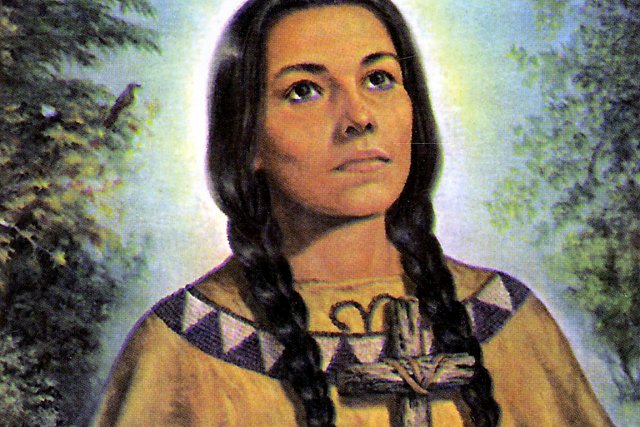_4.jpg/220px-Benedykt_XVI_(2010-10-17)_4.jpg) |
| Nice hat, mind if I stomp on it? |
 |
| Jesus made me glow in the dark |
Here's what I have ascertained. Some time around 1656, Kateri Tekakwitha was born to a Mohawk chief and an Algonquin woman who had already converted to Catholicism. Like so many other Native peoples, the Mohawk nation was devastated by a smallpox epidemic that killed both of Kateri's parents and left her scarred and partly blind. Only a few years later, the French attacked the Mohawk and forced them into a treaty that allowed Jesuit missionaries into their villages. By age eighteen, Kateri had met Jesuit Father Jacques de Lamberville and started studying the catechism. According to Allan Greer in Mohawk Saint: Catherine Tekakwitha and the Jesuits (cited at Wikipedia) there were parallels between the Catholic mortification of the flesh and spiritual practice, usually by warriors, among the Mohawks and other Native peoples; I can think of an example myself, the piercing of the skin in the Plains Sun Dance. Kateri apparently started with the Mohawk tradition of sleeping on a bed of thorns and, after moving to a Catholic mission near Montreal, moved on to whips, hair shirts, iron girdles, and even "mutual flagellation" with other women. She maintained her piety and, of course, her virginity until her death in 1680 at the approximate age of 23.
I don't know much about the Catholic practice of becoming a saint, but I do know that there have to be miracles. The first of Kateri's miracles, so the story goes, was at her death. In less than an hour, the disfigurement caused by smallpox had been replaced with a kind of white beauty (you can interpret "white" in variety of ways here). Her fellow faithful soon saw her spirit in an angelic form. Naturally, her remains were treated as relics with healing powers. Over time, she became a symbol among Native peoples throughout the Americas but especially in Canada, and she became known as the "Lily of the Mohawks." Canonization efforts began in 1884. Kateri gained the "venerable" title in 1943 with the papal recognition of the first miracle, and she was beatified in 1980. Her second miracle happened in 2006 and just up the road from where I live here in Seattle. As reported here in the Seattle Post-Intelligencer, a Lummi boy had suffered a basketball injury that got infected which then led to a flesh-eating bacteria spreading swiftly across his body. Just when everything appeared hopeless, the boy's parents pleaded to Blessed Kateri. Then a Catholic nun touched the boy with one of the relics attributed to Kateri, and the next day the infection halted. This was miraculous enough to be recognized by Pope Benedict XVI, and on Sunday, October 21, 2012, Kateri became the first Native American saint.
 |
| The Native American Icon? |
This is all over the news. Keeping in mind my two statements above, you can understand that I am not only skeptical but also, just maybe, a little upset. I know too much, and feel too much, about the atrocities rained down on indigenous peoples in the name of God. I was pissed a few years back when I discovered that Junípero Serra, father of the California mission system, was beatified, because all of my time studying history and archaeology told me that Fr. Serra was directly responsible for the decimation of California Natives by disease, slavery, and outright violence. Even the events of Kateri's life as we (seem to) know them bear this tale out. There is no reason for me to believe that duress of some kind did not play into Kateri becoming a self-torturing Catholic. As for miracles, I am not one to discount the power of faith in times of desperate need, but regardless of any sudden turnaround, the boy has needed thus far 29 surgeries among other procedures. This is the power of medicine, not a bone relic.
I firmly believe in the right to believe what you believe and to do what works for you, with the caveat that it doesn't prevent anyone else from doing the same. I have also been to enough pow wows to know that Jesus does work for some Native Americans; no grand entry happens without both a traditional invocation and a Christian prayer. But it still bothers me. Having a Native American saint is more than just recognizing purported miracles. It is a huge nail in the coffin of Native lifeways, for now a Native woman, one who was scarred for her short life and saw her parents die as the result of European contact, has been raised to the highest level of the religion that brought devastation upon her people and herself...Hell, on my forebears. It's not just that I don't get it, or that I don't buy it. Personally, and I acknowledge it might just be me (tho' I doubt it), I view this event not as a moment to be celebrated but as another in a long line of painful defeats in Native American history.
Religion's a hard sell no matter how you slice it. Since I was raised Catholic, I find it hard not to empathize with and pray to Saints - Jeanne d'Arc is my family's favorite, for instance. But then, I pray to Patrick O'Brian and Voudon lwa so go figure. I think the poor, mixed up Church thought they were doing a "good" thing canonizing St. Kateri. But it may just be another bungled attempt to make something horribly wrong, right. Good post, Lou!
ReplyDelete